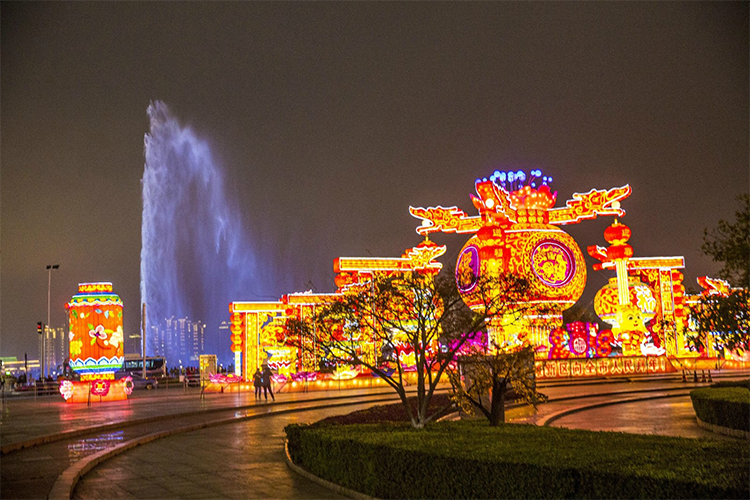Nanchang Autumn Water Square: Must-See Riverside Light & Sound Spectacle
Autumn Water Square, Nanchang: Riverside Light and Sound Spectacle
Nanchang, a rising modern metropolis in central China, is home to a landmark that marries a thousand-year Jiangxi cultural legacy with contemporary urban aesthetics—Autumn Water Square. When night falls, a 128-meter water column cascades like a poured galaxy, facing the ancient Tengwang Pavilion across the Ganjiang River to stage a dialogue across time. This site is not only home to one of Asia’s premier music fountains but also the best viewpoint to understand Nanchang’s “one river, two banks” urban transformation.
1. Modern water features and classical poetry in perfect harmony
“Fallen sunset and solitary birds fly together; autumn waters and the endless sky are one color” — Wang Bo’s famous line from the Tengwang Pavilion Preface is the soul of Autumn Water Square. This 80,000-square-meter waterside space uses the Ganjiang as its natural stage to narrate Nanchang’s story through water. The main fountain’s 128-meter spray reaches roughly the height of a 40-story building; when the water curtain blooms in the night sky, the silhouette of Tengwang Pavilion shimmers in the lights across the river, creating a breathtaking ancient-meets-modern panorama.
The music fountain performance is far more than jets rising and falling—it’s a carefully choreographed “symphony of water.” An 800-meter dynamic light and fountain system dances to both Chinese and Western pieces such as “Ode to the Yellow River” and “Jasmine Flower.” The water shapes change with the music—sometimes fanning like a peacock, sometimes unfurling like a lotus—and on special holidays the fountain projects red-themed water-screen films. The best viewing spot is the curved riverside observation platform on the promenade, where you can take in the fountain and the Ganjiang nightscape at once.
2. Gan Culture Corridor: One kilometer to read Jiangxi’s history
Beyond the spectacle, the east side of the square features the “Gan Culture Corridor,” a 60-meter bronze relief wall that resembles an unfolding historical scroll. Twelve themed panels condense Jiangxi’s civilizational highlights—from the ancient Xianren Cave settlements to the heyday of Jingdezhen porcelain, from Lushan’s Bailudong Academy to the red spark at Jinggangshan. Each detail was vetted by historians.
Notable is the “Tengwang Pavilion Elegant Gathering” scene, which meticulously recreates Wang Bo composing his famous poem on the spot. The reliefs use Jiangxi’s distinctive bronze-casting techniques; run your hand across them and you can almost feel the artisans’ touch. Visit during daylight for the best light to appreciate the fine carved motifs—many of which are drawn from decorative elements found in Jiangxi’s historic architecture.
3. Constellation Plaza and urban leisure aesthetics
The square’s design is full of contemporary urban touches. The Constellation Plaza is inset with twelve bronze zodiac sculptures and has become a favorite photo stop for young visitors. At night these constellations glow a soft blue, echoing the starry sky above. Families should not miss the interactive fountain zone where children can splash between jets—the area is full of laughter in summer.
An 800-meter wooden boardwalk along the river is a beloved walking route for Nanchang residents: couples stroll hand in hand at dusk, elders fish by the rail, and photographers set up tripods to capture the city lights. Looking west from the waterside platform, you’ll see the Red Valley (Honggutan) financial district’s skyscrapers glittering, their reflections forming a perfect postcard view. Bring a tripod and use long exposure to catch the light trails of ferries crossing the river.

4. Practical visitor guide
Best time to visit: Fountain performances run nightly from 19:30–21:30 (extended to 22:00 in summer). Arrive 30 minutes early to secure a good spot. Extra shows are scheduled on Friday and Saturday nights, with special programs on public holidays.
Getting there: Metro Line 1, Autumn Water Square Station, Exit 5 leads directly to the plaza. From Tengwang Pavilion you can take Bus 51 or a taxi across the Bayi Bridge (about 15 minutes). Drivers can use the underground parking at Honggutan Wanda Plaza (a 5-minute walk).
Nearby pairings: Visit Tengwang Pavilion in the daytime (open 09:00–17:00), then head to Autumn Water Square at dusk and finish with a ten-minute walk to the Nanchang Star Ferris Wheel—the third-tallest in the world—for a perfect three-landmark day.
Local tips: Weekdays, especially Wednesday and Thursday, are less crowded. Try local favorites like Nanchang tossed noodles and claypot soup at riverside eateries before the show. Winters can be windy along the river—dress warmly.
5. A cultural evening in the city’s living room
When the last notes of the symphony fade and the water screen lowers, the most moving part of Autumn Water Square is not the technology but the ordinary lives playing out there—grandparents snapping family photos by the river, teenagers skating past the constellation plaques, photographers waiting patiently for the perfect frame. The plaza is both a city reception hall and an extension of everyday life.
Standing on the Ganjiang’s shore with the thousand-year eaves of Tengwang Pavilion on one side and the modern Red Valley skyline on the other, with water sprites dancing to music between them, you feel Nanchang’s city temperament of “past and present in harmony.” Whether you’re a cultural traveler, a photography enthusiast, or simply want to feel a city’s pulse, Autumn Water Square’s night is worth a special trip.



